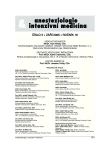-
Medical journals
- Career
Development in anaesthetic technique in the extremely low weight infant, 1998–2003
Authors: V. Mixa 1; K. Cvachovec 1; J. Kalousová 2; M. Rygl 2
Authors‘ workplace: Klinika anestezie a resuscitace UK, 2. lékařské fakulty a IPVZ Praha, FN Motol, Praha 1; Klinika dětské chirurgie UK, 2. lékařské fakulty, FN Motol, Praha 2
Published in: Anest. intenziv. Med., 16, 2005, č. 5, s. 229-234
Category: Anaesthesiology - Original Paper
Overview
Objective:
Analysis of anaesthetic techniques in the extremely low weight infants, 1998–2003. Establishing the optimum general anaesthetic technique.Design:
Retrospective observational study.Setting:
Dept. of Anaesthesia and Intensive Care, University Hospital, Prague, Dept. of Paediatric Surgery, University Hospital, Prague.Materials and Methods:
Using the medical documentation of 118 paediatric patients (135 surgical procedures) weighing less than 2,500 g on the day of surgery, we recorded the basic demographic data, surgical diagnoses and methods of general anaesthesia and/or neuromuscular blockade. Incidence of invasive anaesthetic procedures and the duration of surgical procedures were compared. The resulting values were entered into tables, completed with percentages when necessary and/or expressed as range of the highest/lowest values and average values.Results:
While in the first year of the monitored period (1998) opioid-based anaesthesia supplemented with isoflurane dominated (48 %); in 2003 inhalational anaesthesia using sevoflurane supplemented with sufentanil was used in 90.3 % cases. Vecuronium was replaced by atracurium/cis-atracurium for neuromuscular blockade. The most frequent surgical diagnoses were oesophageal atresia with tracheo-oesofageal fistula, ileus, atresia of duodenum and abdominal wall closure defects. During 1998–2003 the number of invasive anaesthetic procedures increased (central venous catheter 20–38 %, arterial cannula 4–48 %, epidural catheter 8–33 %).Conclusion:
General anaesthesia with sevoflurane supplemented with sufentanil and cis-atracurium is the method of choice in the anaesthetic management of the newborns indicated for major surgical procedures. It may be complemented with epidural analgesia, invasive arterial pressure monitoring and central venous catheterisation.Key words:
general anaesthesia – anaesthesia of newborn – sevoflurane – opioid in anaesthesia of newborn – neuromuscular blocking drugs in anaesthesia of newborn
Labels
Anaesthesiology, Resuscitation and Inten Intensive Care Medicine
Article was published inAnaesthesiology and Intensive Care Medicine

2005 Issue 5-
All articles in this issue
- Development in anaesthetic technique in the extremely low weight infant, 1998–2003
- Some prognostic indicators in elderly patients in intensive care
- Curare: Alternative methods of administration
- Curare: Some historical facts
- History of regional anaesthesia in former Czechoslovakia and worldwide
- The training of military anaesthetists for mass casualties, 1960–1980
- The Czech contribution to the advance in the interpretation of acid-base disturbances
- Fighting disease and accepting dying
- Anaesthesiology and Intensive Care Medicine
- Journal archive
- Current issue
- Online only
- About the journal
Most read in this issue- Curare: Alternative methods of administration
- Curare: Some historical facts
- Development in anaesthetic technique in the extremely low weight infant, 1998–2003
- The Czech contribution to the advance in the interpretation of acid-base disturbances
Login#ADS_BOTTOM_SCRIPTS#Forgotten passwordEnter the email address that you registered with. We will send you instructions on how to set a new password.
- Career

